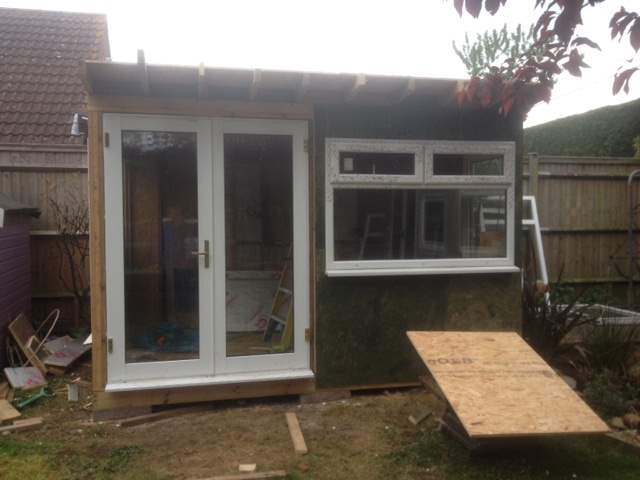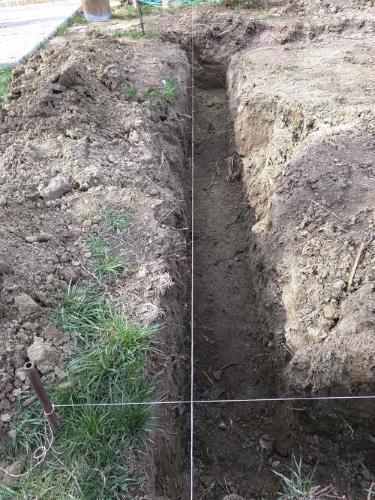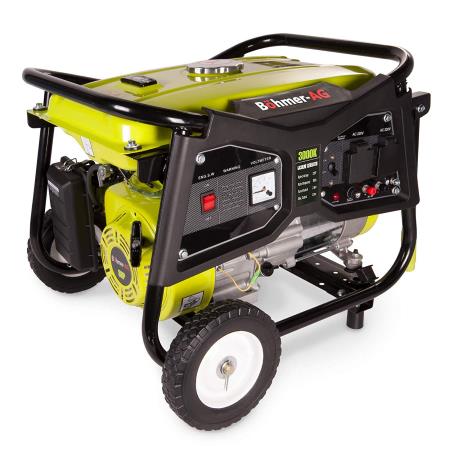Blog

Backyard Office Sheds With No Electric, Water Nor Drainage
So you finally have some land to build your dream backyard office shed or writing studio – congratulations! However, some obscure local planning rule means that you cannot run utilities (like electric and water) to it… or perhaps the land host is not willing for their award-winning garden to be dug up for utilities to be installed. Does this mean your dream office idea is dead? Thankfully it does not – so let’s explore the options.
For electric, you could always look at running a temporary extension cable only when you will be using the backyard office – just like RV’s have an outside master power outlet to connect up to. A small gasoline-powered generator is another alternative, as-is relying on battery power (laptops, portable lights) for work sessions of only a few hours.
For water and drainage, you could pre-figll a large water container (like offices have above their water coolers), or store drink water in a large jug or prefilled kettle. Any waste drink water could go into a small jug and be emptied in the house or even the backyard. If you need to use the toilet, you could install a composting toilet – or simply use your house’s toilet. Finally, you can buy hand sanitizer gel or waterless soap for ensuring your hands are clean.
Possibly Reasons Why You Cannot Run Utilities

There can be quite a few reasons why you are unable to run water, electric and drainage (as required) to your office shed build:
- You own the land, however, running utilities to your backyard office would fall foul of local zoning/planning laws which would no longer see your planned build as a “simple shed”, and instead start treating it as more of a fully-fledged building or detached studio. Then they suddenly want architectural plans and more building permit fees before they will sign-off on your dream office shed. In this case, you might decide that you can do without dedicated utility runs and instead look for alternative solutions.
- It is not your land: perhaps it is a friend or family’s land. And due where you are planning on putting the backyard office, the ‘land host’ would not be happy with you digging up their prized flowers and garden lawn for you to run water pipes and electric cables to your building. You could always try the It’s better to ask for forgiveness than permission” advise and do it when they are not looking, but this will almost certainly screw up your relationship and put a stop to your dream office shed plans. In other words, do not try this out – stick to your host’s rules!
- There are building restrictions for whatever reason – maybe you have a backyard on the ground floor of an apartment block, where certain building work is restricted. Or possibly you are looking at converting a garage, but the homeowner (assuming it is not you) is not willing for you to hook into their utilities. Either way, if you are restricted from running/extending utilities, you will also need to look for alternatives.
Electric Alternative #1: Extension Cable
If running fixed overground or underground electrical cable is not an option, try and see whether running a temporary extension cable is an option. This might involve running a heavy-duty extension cable from a garage or main house and hooking it up to an RV-style outdoor power outlet. This can then be used to power the whole backyard office as required, and if it is sufficient for powering the various electronic equipment inside an RV for a holiday or trip, then it should be sufficient for powering an office shed and its equipment for a few hours or the working day.
Obviously, a key consideration here is why you were unable to run a fixed electrical cable in the first place and whether a temporary extension cable (which might be running through the backyard of the garden for 8+ hours a day) will equally cause an issue for the land host.
If this is an option, though, then be sure to get a heavy-duty extension cord (instead of a quick, cheap alternative) because the cord will need to protect against it being too cold, it being too hot, it being too rainy… and also it being icy/snowy! It will also need to have a high amperage/wattage rating, to protect against potential power surges and to give consistent power to your electrical devices. In other words, do not skimp and buy a cheap extension cord: if you are planning on this being the sole power source for your office shed, then pay for a sufficiently good quality one.
Electric Alternative #2: Generator
Another option is an electrical generator. Your first thought when we say this might be massive, 5-figure-priced generators in hospitals and apartment blocks. However, you can buy smaller power generators nowadays for as little as a few hundred dollars.

These cheaper “mini generator” type models can still pump out 1,900+ watts of electricity: which is usually more than plently to run a couple of computer systems (a typical office desktop computer will use 300-400 watts, a standard laptop is less than 200 watts and lights are usually less than 25 watts). A kettle can use quite a lot of power, however: sometimes as much as 2,000 watts. They are a rarity nowadays in the sense that they use more power as time goes on, whilst most devices are using less power: this is due to the growing demand for kettles which boil ultra-quickly. Luckily you can buy lower power kettles which demand a lot less from an electrical supply: camping kettles are perfect for this. Yes, they take a while longer to boil, although you probably will not have a long walk from your office desk to your office kettle!
In terms of generators themselves, there are many models available so the main things we would suggest to look for are:
- Output: ones which generate a sufficient level of electricity for your needs, which could be as little as 1,000 watts – but you probably want some ‘growth room’ in case your electrical needs expand in the future.
- Price: a little obvious, but be sure to compare on price. There are some really expensive generators which output a similar amount of electric compared to much cheaper models, but the reviews are not immediately clear as to why. If you can get a good enough generator for your needs at a low price, then definitely do this.
- Noise: check the decibels output for the generator, because you obviously would not want one that is very noisy and distracting to your work (or the neighbors!). Luckily there are a lot of generators nowadays which are quite low noise but do be sure to check this in case you end up with a noisy one.
- Gas usage: the fuel consumption of a generator is a key measure to keep track of. You ideally want one that will last as long as possible per gallon of fuel, to save you heading to the gas station with a jerrycan all the time. Naturally, if a generator has a massive power output, it will generally use more gasoline than a lower-output model: so (as per point #1) be sure to buy a generator which matches your requirements.
Electric Alternative #3: Battery Power
Another option for a backyard office without a dedicated electric supply is… to do nothing. Okay, that sounds like rubbish advice so let’s explore this more. Battery technology is getting better every day: some cell phones can last days without a charge, you can buy laptops which are designed from the ground-up to have long battery life, and you can get battery powered lights (assuming you need extra light).
In other words, consider whether you are able to get by without an electrical source at all and just by relying on battery power. This is especially possible if your backyard office is mainly intended as a writing studio (which may not even need any electrical devices: some writers find minimalism with no distractions the best), although if you need a slightly higher spec laptop and will be making phone calls throughout the day then you will need to think more carefully.
A smart phone with power saving mode enabled (which both Android and Apple phones offer as standard) can have double the battery life to normal, or you can even buy a simple cell phone without any smart capability (i.e. one which can just make and receive calls and SMS text messages) – just like in the old days – since these simpler cell phones could sometimes last a week without needing a charge. Either of these options should get you through a working day without needing to charge up, though.
A laptop is a little trickier because if you are using it extensively throughout the entire day for high-CPU uses, then many laptops would struggle to offer 8+ hours of battery life. However, you can also enable a power saving type mode: Windows 10 has a “Battery saver” option which turns off some data syncing, and will prolong the battery life of your laptop (and a Macbook has similar options). Then it is just a case of checking the battery life of your intended laptop. Some MacBook Air models claim to offer over 10 hours of battery life, whilst some Windows-based ‘ultrabooks’ also claim similar battery life figures.
If you can get by without any form of electrical wiring, it will make your backyard office build a lot easier (and cheaper): it is then essentially just a decorated and insulated (office) shed!

Water Alternatives: For Drinks
If you are building a tiny house, you will obviously need a water and drainage supply. However the need for water (and drainage) supply in a backyard office shed is more down to personal preference.
If you are happy using the main house for drinks and restroom breaks then you will not need water or drainage supplies at all. However, if you find it an annoyance to constantly go into another building to make drinks, then you have a few options:
- Buy a big water container, just like you see in offices above the water cooler. You can fill this up once a week, and then use it for making cold and hot drinks as needed.
- If this is a little overkill just for you, buying a larger-than-average jug for your drinking needs is also an option – and then you can refill this daily.
- Buy bottled drinks, and then store these in the office shed or take a couple in with you each morning.
- If you are mainly a hot drink person, then pre-filling a kettle daily (or twice a day, once in the morning and once lunchtime for example) would also work well – albeit it would take a while to boil when it is full up.
Water (And Drainage) Alternatives: For Restroom Breaks
Just having access to water for drinks is easier, but what if you are not willing – or are unable – to use the main house’s toilet? We already know that you cannot get a water supply, and certainly not a large toilet-drainage supply, so what are the options?
In this case, you would need to go down the route of buying and installing a composting toilet. Luckily these are quite easy to install because you can get various waterless models which (as you have probably guessed) do not need a water supply! These would only need emptying every few weeks or months and could be a good option. For washing your hands, hand sanitizer or waterless soap (or both!) could work out well.
A composting toilet works by using a mix of liquids already in the toilet (in other words urine) and a ‘carbon additive’ (like sawdust or peat moss) after a ‘solid movement’ (in other words a poo), and then the composting toilet’s microorganism process takes hold and breaks down the solid waste into a compound which can be more easily disposed of every few weeks or months.
You also do not need to worry about smells, because composting toilets have a constant negative pressure inside the unit which means that smells do not permeate back from the toilet to the rest of the building.